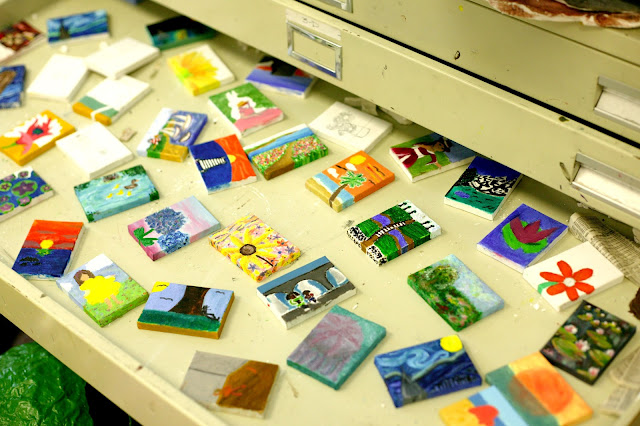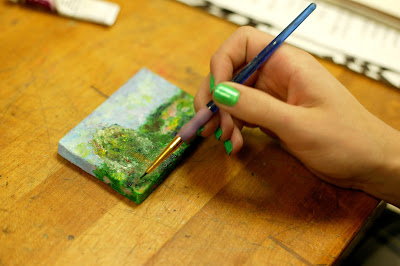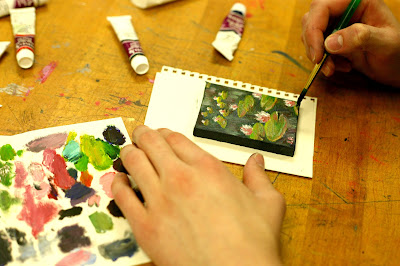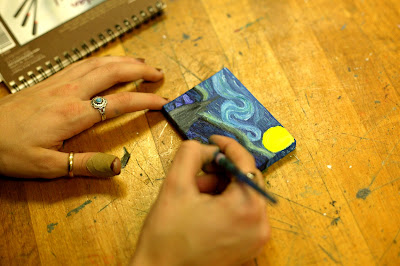Last year I tried to do this and it sort of tanked. My intent was to offer up an opportunity for the students to be able to look at artwork of history that has been regarded by many as the most masterful (Michelangelo, DaVinci, Rembrandt, Monet, etc.) and draw some inspiration from them to create their own pieces. The easiest style for them to create inspired works is (of course) in impressionistic style. Of course, it's hard to NOT look at all of the styles before that and not want to try and go in that direction. But, you know? We can't all be whipping out the Sistine Chapel, right? Anyway...
How do you take inspirations like that and make a project that is both approachable but not completely compromised and totally scholastic looking? What materials do you use that are still serious in feel but now overwhelming to work with?
Enter: smaller canvases and a media that feels a little more serious.
Translation: Mini canvases on mini easels and water-miscible oil paints.

The student work for this project this round far exceeded my expectations. The funny thing is, I spent less time looking at and dissecting and analyzing the original works that served as the inspiration. In theory I feel like that should have yielded student work that was much lower in complexity and quality overall. *shrug* I guess I really did take the extra time from the lecture and give it back to the students for their projects but I don't know. Whatever the case, we took one class to look at works and then almost a solid week and a half of class time (so, I think, six meetings of 55 minutes?) in order to give the paints a solid week to set, dry, and cure in time for Mother's day. (Water miscible oils definitely dry in less time than real oils BUT they still take a significant amount of time to dry longer than acrylics. I'll say they take 3-5 times longer depending upon how heavy handed you were with laying the paint down.)



Here are some of the best finished pieces turned out. I am really bursting with pride at how hard the students work, how truly invested they were about them, how enthusiastic they were to come to class every day, and the level of complexity that yielded overall. I cannot believe I get to work with student artists who makes stuff like this every day when I come in to work.
Some tips if you try this out in your classrooms...
- Set aside brushes that are on the medium to very small size (of bristles) that will be used only for this project to ensure that the students have the right tools for even the tiniest detail work
- Set aside a little more time than what you think you might need for the painting of the pieces
- Set aside at least that much time and a half to fully set, dry, and cure the finished works
- Definitely get the mini easels because they really do make all the difference with making the pieces feel even more finished and refined. I know they can be expensive but it's worth it.
The students will be delivering these to their mothers this weekend in time for Mother's day celebrations. I gave them plain white envelopes and surplus color tissue paper for wrapping/packaging purposes and gave them a chunk of class time yesterday to decorate the envelopes and package everything up. The students were so excited that most all of them admitted that they would probably be gifting them to their mothers as soon as they saw them after school because they just couldn't wait until Sunday. I think that's both sweet and very cool.

































